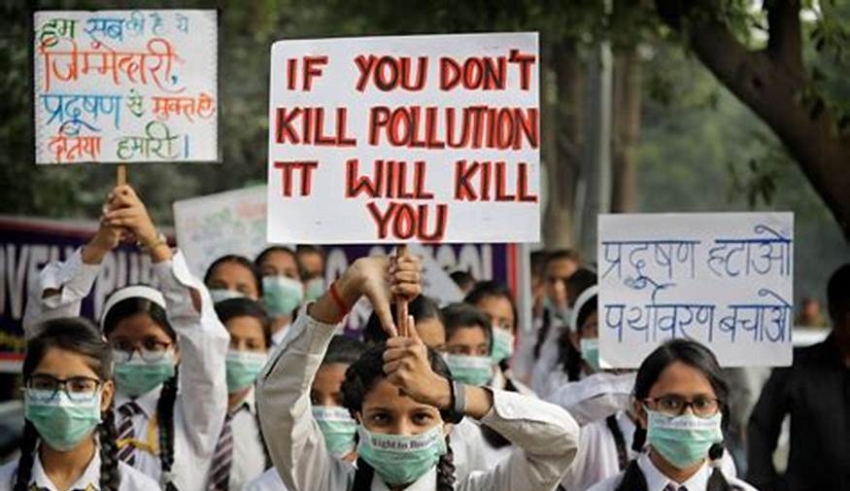
By Dr. Devesh Kumar Singh, Chairman of Noida International Institute of Medical Sciences & Noida International University
 Air pollution is an unexpected enemy that college students must contend with in the busy cities of India and elsewhere. The increasing amounts of air pollutants are proving to be more than just a minor inconvenience; rather, they pose a serious risk to students’ mental health and ability to learn.
Air pollution is an unexpected enemy that college students must contend with in the busy cities of India and elsewhere. The increasing amounts of air pollutants are proving to be more than just a minor inconvenience; rather, they pose a serious risk to students’ mental health and ability to learn.
Let’s examine the complex network of psychological and physical problems that are made worse by air pollution and consider workable solutions for this silent but powerful obstacle.
The Unseen Culprit: Air Pollution’s Multi-Faceted Assault
In the modern world, air pollution is a ubiquitous problem that has long been linked to respiratory issues. However new research suggests that its effects go beyond the lungs and into the very structure of mental health. This means that college students have to deal with a wide range of psychological and physical problems that can seriously impair their ability to learn.
The Numbers Speak Volumes: Statistical Insights
91% of people on the planet, according to the World Health Organisation (WHO), reside in regions where air quality is higher than recommended. The situation is especially bad in India, which has some of the most polluted cities in the world. The recommended limit of 10 micrograms of PM2.5, a fine particulate matter that can enter the lungs, is often exceeded by the annual mean concentration of PM2.5, which can reach up to 100 micrograms per cubic meter in cities like Delhi.
In Bangalore, the National Institute of Mental Health and Neurosciences (NIMHANS) conducted a study that revealed a strong link between college students’ increased prevalence of anxiety disorders and depression and their exposure to air pollution. According to the study, students who were exposed to higher pollution levels had a 1.5-fold increased risk of mental health problems compared to those who were in cleaner environments.
The Double Bind: Physical and Psychological Implications
Already, college life is a difficult stage filled with demands from coursework and transitional times. Another level of complexity is the aggravation of psychological and physical problems as a result of air pollution. Numerous health concerns, such as immune system dysfunction, cardiovascular problems, and respiratory ailments, have been connected to long-term exposure to pollutants. These health issues make the classroom unfriendly, which makes it difficult for students to concentrate, stay involved, and perform well in their coursework.
Beyond its effects on cognition, air pollution has been connected to a higher risk of mental health conditions like depression and anxiety. The hazardous concoction of contaminants not only penetrates the lungs but also enters the bloodstream, where it may have an impact on the brain and cause inflammation. There is evidence linking this neuroinflammation to an increased risk of mental health problems. Although college campuses are supposed to be places of learning and development, for many students they have turned into front lines in the ongoing struggle for mental health.
Strategies for Coping: A Breath of Fresh Air for Students
- Mindful Campus Planning: Academic establishments can significantly contribute to reducing the negative effects of air pollution on pupils. Planning for campuses should give special attention to green areas, include air purification systems, and promote environmentally friendly transit choices.
- Health and Wellness Programs: It’s critical to implement all-encompassing programs that address mental health issues. Student support systems such as awareness campaigns, stress management workshops, and counseling services can help them deal with the psychological effects of air pollution.
- Government Intervention: Strict Air Quality Guidelines Governments need to give strict air quality regulations top priority when it comes to implementation and enforcement. To reduce air pollution, it is imperative to monitor industrial emissions, invest in cleaner technologies, and encourage public transportation.
- Community Involvement and Advocacy: Students can become effective change agents. They can strengthen their combined voice in the battle against air pollution by taking part in environmental awareness campaigns, working with legislators, and leading community-led projects.
- Personal Protective Measures: Students can take charge of their immediate surroundings by being encouraged to take personal protective measures, such as donning masks during times of high pollution and keeping up with air quality conditions.
Governments, academic institutions, and students must work together to combat air pollution as the mental health troll continues to wreak havoc on college campuses across the globe. We can establish a learning environment free from the silent but potent threat of air pollution by putting into practice comprehensive strategies that address the psychological and physical effects of poor air quality.







